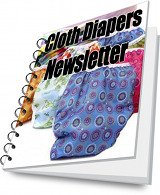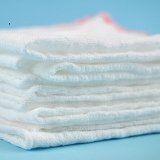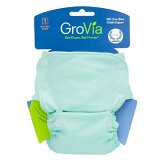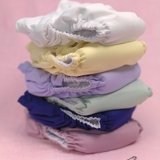Diaper Fabric
There are a lot of options available when it come to cloth diaper fabric. Each type of cloth diaper fabric comes with its own strengths and limitations, so whether you are planning to buy ready-made cloth diapers or if you want to make your own diapers, either way, it's wise to know a bit about each type of fabric that is used to make cloth diapers.
Fabric Used for Soakers (the absorbent layer)
Cotton Diapers
Cotton comes in many forms (terry, flannel, etc.) and is the most common material used for cloth diapers. Cotton is absorbent and soft, and cotton cloth diapers are readily available. Keep in mind that traditional cotton farming uses a lot of pesticides, and, if you're using cloth diapers to be kinder to the earth, you may want to consider using organic cotton diapers.
Birdseye Diapers
Birdseye diaper fabric is very easy to recognize with its tiny diamond-shaped weave. It becomes softer as it is washed several times, and it is quite absorbent.
Terry Diapers
Terry cloth, an uncut (looped), pile weave fabric is typically made from cotton. The deeper the pile, the more absorbent the fabric will be.
Organic Cloth Diapers
If you plan to use organic cloth diapers you will have several fabrics and diaper styles to choose from. While organic cotton diapers may be the first diaper fabric that comes to mind, you may also choose from hemp diapers, bamboo diapers or organic wool diaper covers if you want to go organic.
Hemp Diapers
Hemp diapers can be an excellent cloth diapering option. Hemp has several benefits; it is mildew resistant, naturally anti-microbial and extremely absorbent, which makes it a good choice for heavy wetters or for use at bed time.
Bamboo Diapers
Bamboo diapers have a lot of advantages over other cloth diaper fabrics. Bamboo is very absorbent, breathable, tends to wick moisture away from baby's skin, and it quite soft.
Flannel Diapers
Flannel is very soft and warm. Flannel is generally made from cotton, and it is the material that most baby blankets are made from. It fact, if you find yourself with more baby blankets that you can use, and you're handy with a sewing machine, you may want to turn a few of your baby blankets into soakers, or diaper doublers. Flannel does tend to fade and to stain, and lower quality flannel will pill with just a few washings.
Velour
Velour is an extremely soft fabric that can be made from cotton (traditional or organic) or bamboo. Bamboo velour is more absorbent, but cotton velour is less pricey and easier to find in stores.
Sherpa
Sherpa is a fantastically soft, fluffy and absorbent material that works well as an absorbent soaker. Sherpa is generally a blend of cotton and polyester with a higher cotton content and a small amount of polyester added.
Fabric Used for Diaper Covers (the waterproof layer)
Wool Diaper Covers
Wool diaper covers, which are also sometimes called soakers, are considered the top of the line in cloth diapers by many parents. you may choose from traditional wool diaper covers or organic wool diaper covers.
Fleece Diaper Covers
Fleece is extremely soft and comes in several varieties. It tends to wick moisture away from the baby's skin, so, while it will keep your baby dry, when fleece is used as a diaper cover, it can get damp if diapers aren't changed frequently.
Because fleece is so soft and wicks away wetness, it is sometimes used as an inner layer in cloth diapers. Fleece is not absorbent enough to be used as the main soaker/absorbent layer, but it works well when used as a layer that goes between baby's skin and the absorbent fabric layer.
Vinyl Diaper Covers
Vinyl diaper covers are inexpensive and readily available in stores. However, they do not provide good airflow, they trap heat within the diaper, and they provide no wicking action, so they also trap moisture near your baby's skin. Vinyl baby diaper covers can also contain harmful phthalates. Vinyl is not a diaper fabric that I would personally recommend.
Polyurethane Laminate (PUL)
PUL diaper covers are somewhat shiny, and they vary in thickness and feel from brand to brand. This diaper fabric is very commonly used, durable and relatively inexpensive.
Like Cloth-Diapers-Online.com?









New! Comments
Have your say about what you just read! Leave me a comment in the box below.